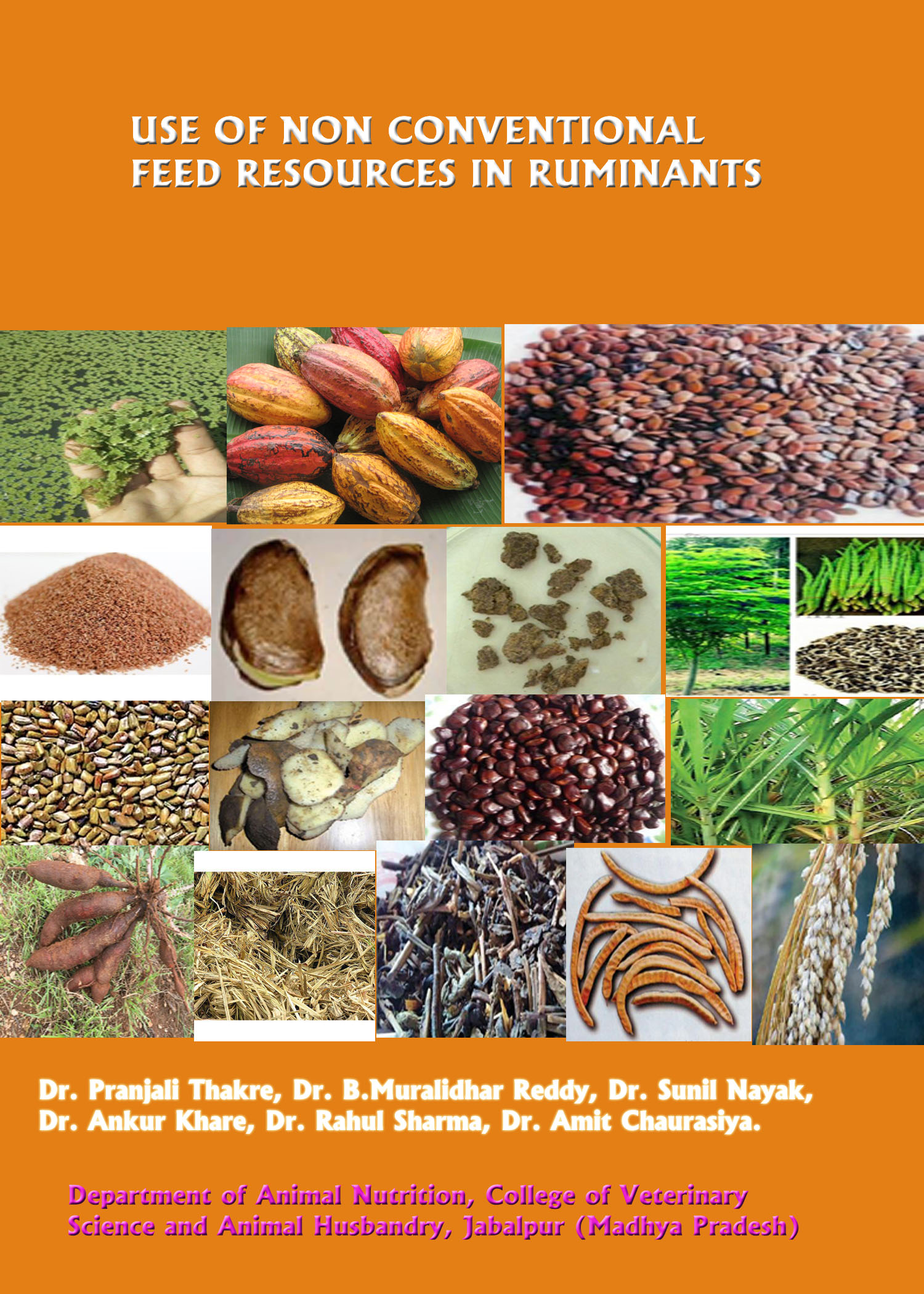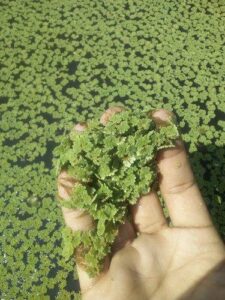USE OF NON CONVENTIONAL FEED RESOURCES IN RUMINANTS
India with only 2.29% of land area of the world, has largest livestock population in the world. This creates a huge pressure on land, water and feeding resources. The feed of ruminants is divided into 3 components- Green fodder, Dry fodder and Concentrates. On all India basis, statistics show that there is deficit of 11.24% for green fodder, 23.4% for dry fodder and 28.9% for concentrates. This creates imbalance in demand and supply of the feed resources which indirectly affects the production of livestock. To narrow this gap between the demand and supply, the non-conventional feed resources (NCFR) play a major role.
The non-conventional feed resources (NCFR) refer to all those feeds that have not been traditionally used in animal feeding and or are not normally used in commercially produced rations for livestock. NCFR include commonly, a variety of feeds from perennial crops and feeds of animal and industrial origin. Increase in livestock and human population and decrease in land under cultivation has resulted in acute shortage of feeds and fodder for livestock which further increases due to natural calamities like droughts and flood. Their use in livestock ration is increasing day by day due to shortage of animal feeds. The main source of such feeds is agricultural and forest by-products. Such feeds are not used either because of traditional beliefs of livestock owners or due to less palatability and presence of incriminating factors in them. It also happens that certain non-conventional feeds are being traditionally fed to animals in particular region but the same may be neglected in other regions. In India, during monsoons, there are ample feed resources. But for the remaining periods of the year, the animals have to be maintained on the crop residues or straws of jowar, bajra, ragi, wheat, barley, etc. either in the form of whole straw or bhusa, supplemented with some green fodder, or as sole feed. These feedstuffs can be put to use for animal feeding as they provide no competition from human counterparts. Mostly these are the byproducts which are obtained after removal of main product for human use. These feedstuffs can be put to use for animal feeding as they provide no competition from the human counterparts. Mostly these are the byproducts which are obtained after the removal of main product for human use. The bran obtained by sieving wheat flour, bagasse obtained after removal of cane juice from sugarcane, sugarcane tops, maize bran, rice bran, rice husk, the mustard seed hulls or stem of mustard seed hulls or the stem of mustard plant after drying and treating it with molasses, etc which are inedible for human population can be used for animal feeding. The ruminants being excellent recyclers can recycle such wastes and byproducts into valuable products.
The Unconventional feeds are described under following categories:
- Protein sources
- Energy sources
- Miscellaneous unconventional feeds
Protein sources
- Ambadi cake
Common names: Ambadi, Mesta, Deccan Hemp, Brown Indian Hemp
Local names: Patsan , San
Nutritive value: It is a very good source of energy 60% TDN and protein 23.4% CP.
The cake doesnot contain any toxic factor and is quite palatable.
Inclusion: It can be incorporated at 20% level in concentrate mixture of crossbred calves and lactating cows yeilding daily 12.9 kg milk.
- Corn gluten meal
Common names: Maize , Corn
Local names: Makka, Makai, Bhutta
Nutritive value: It contains about 58% CP and 80% TDN.
- Guar meal
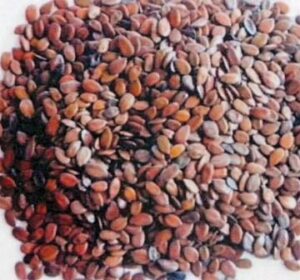
- Common names: Guar, Cluster beans, Calcutta Lucerne, Gum bean.
Local names: Gawar, Guwar, Guaar, Goaar
Nutritive value:It contains CP – 50-55% TDN- 75-80% and is good source of amino acids lysine (2.55%), cysteine (1.16%) and glycine (4.61%).
Deleterious factor: It conatins two anti-nutritional factors i.e. anti-trypsin and guar gum. Toasting can be followed to inibit anti-trypsin.
Inclusion: 10-15% level in cows and 5-10% in calves.
- Isabgol gola
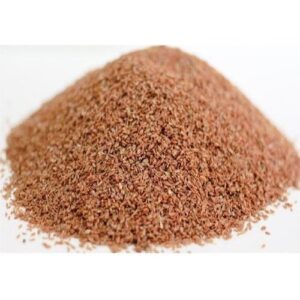
Common names: Plantago, Isphagula, Psyllium husk, Psyllium seed
Local names: Isabgol
Nutritive value: Isabgol lali contains 30-40% CP and 21% EE, 1% CF, 28.1% NFE, 1.4% P and 0.9% Ca on dry matter basis.
Inclusion: Isabgol lali and gola can be used upto 25% and 50% inclusion level respectively in concentrate mixture for cattle.
- Niger seed cake
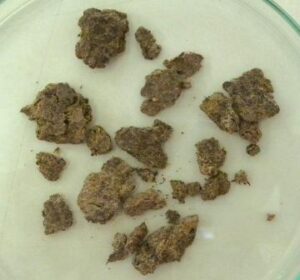
Common names: Ramtil, Niger, Blackseed
Local names: Ramtil, Kalatil, Surjuga, Jagni
Nutritive value: It is very good source of protein (CP 34%) and a moderate source of TDN (50%). It does not contain any toxic factor.
Inclusion: It can be incorporated upto 57% in the concentrate mixtures of crossbred calve.
- Rubber seed cake
Common names: Rubber, Para rubber
Nutritive value: A good quality Rubber seed cake contains about 35% CP and 55% TDN.
Deleterious factor: It contains hydrocyanic acid but its level is too low to produce any toxic effects.
Inclusion: It can be incorporated up to 30 and 25% respectively, in concentrate mixture of crossbred calves and milch cattle.
Common names: Wild tamarind, White babool, Lead tree, Shack shack
Local names: Safed babool, Subabul
Nutritive value: Subabul seed contains 65% TDN and 29% CP.
Deleterious factor: It contain toxic principle mimosine which has adverse effect on growth, reproduction and health of animals. The mimosine content can be reduced by soaking the seeds in water and drying. The addition of iron salts decreases mimosine toxicity.
Inclusion: When subabul seeds are used in feed, it is advisable to
add iron and iodine containing mineral mixture. Subabul as green
fodder should not be used more than 33% of total ration. Subabul
seeds can be safely used up to 10 and 30% level in concentrate
mixture for lactating and growing animals, respectively. They can be used up to 30% level in the ration of adult bullocks.
Energy sources
· Vilayati babul pods
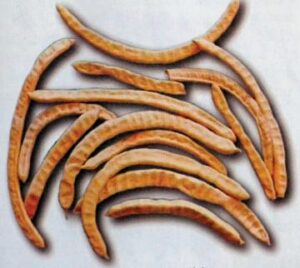
Common names: Algaroba, Mesquite
Local names: Junglee kikar, Vilayati babul
Nutritive value: Babul pods are very good source of energy(TDN 65%). It contains about 12% CP.
Deleterious factor: The pods contain about 0.74 to 1.5% tannins which is very low and does not produce any harmful effect on animals.
Inclusion: The pulp of pods contains about 20-30% water soluble sugars, most of which is sucrose and are greatly relished by the
livestock. Vilayati babul pods should not be used as such as its seeds
are very hard so animal can not digest it and comes out as such with
faeces. Therefore it should be fed after grinding. The ground pods
can be incorporated at 20% level in the concentrate mixture of crossbred calves. These can be included at 30% level in the concentrate mixture of lactating cows and 40% level in the ration of adult bullocks.
· Apple waste
Nutritive value: It is a good source of energy (TDN60%). The protein content is 12%.
Inclusion: After slicing, drying and grinding these can be incorporated as energy source upto 30% level in the concentrate mixture of crossbred calves replacing 100% maize.
· By-products of tapioca (Tapioca starch waste)
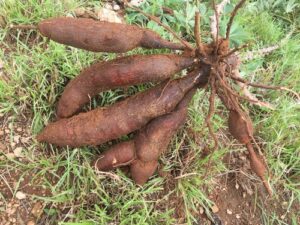
Nutritive value: It contains about 8-12% CP. It is a good source of energy (TDN 60-65%). It contains hydrocyanic acid (HCN) hence it should be fed after HCN testing
Inclusion: For adult cow it can be safely used upto 30% level in the concentrate mixture.
· Cocoa pods
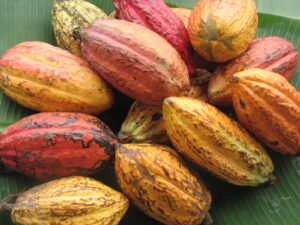
Common names: Cocoa, Cacao, Chocolate
Nutritive value: It contains 63.5% TDN and 6.3% DCP.
Deleterious factor: Cocoa beans contains theobromine, an alkaloid poisonous to animals. The level of theobromine is very low in pods.
Inclusion: Fresh pods are sometimes consumed by livestock, but to ensure that the animals consume sufficient quantities, the pods must be sun dried (to 60% moisture content) and then chopped, ground and pelletized. Pod meal has been fed to cattle without toxic effects in
quantities upto 7 kg per day.
· Coconut pith
Common names: Coconut
Local names: Nariyal
Nutritive value: It contains about 62.7% TDN.
· Mango seed kernel
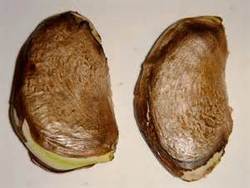
Common names: Mango
Local names: Aam, Mangga, Amba
Nutritive value: Mango seed kernel is poor source of protein (6% CP). The TDN content is 55%.
Deleterious factors: It contains high level of tannins(5-6%). Therefore its more use in animal feed may affect growth and health of animals.
Inclusion: The kernels can be incorporated up to 10% level in the concentrate mixtures of milch cattle. It can be safely used up to 20
and 40% level in the ration of growing calves and bullocks,
respectively.
· Tamarind seed powder
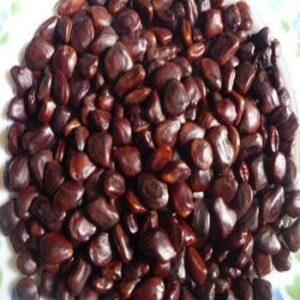
Common name: Tamarind
Local names: Imli, Tentul, Chinch
Nutritive value: Tamarind seeds contains 30-40% red hulls and 55-70% white kernels. Tamarind seed kernels are good source of energy (TDN 64%). It contains 12% CP.
Deleterious factors: Tamarind seed contains tannin (13-14%) as an anti-nutritional factor. Overnight soaking in cold water reduces the tannin content.
Inclusion: Tamarind seed can be fed after grinding during scarcity period. It is not very much palatable. To make the seeds palatable to cattle, they
should be ground and soaked in water for an hour before feeding.
Miscellaneous unconventional feeds
· Azolla
Local names: Azolla
Nutritive value: Azolla is rich in protein, almost 20-25% CP on dry matter basis. It also contains essentisl minerals like iron, calcium, magnesium, phosphorous, copper, manganese, etc. apart from appreciable quantities of vitamin A and vitamin B12. It is also found to contain almost all the essential amino acids, many probiotics, bio-polymers and beta carotene.
Inclusion: Livestock and easily digest azolla due to its high protein content and low lignin content. Fresh azolla can be mixed with commercial feed in the ratio 1:1 or given directly to livestock . It was found that the milk production in the cattle increased by 10-12% when they were fed with
azolla. It is also found that azolla feeding improves quality of milk.
· Babul pods, seeds and babul seed chuni
Common name: Gum Arabic
Local names: Babool, Kikar, Babul
Nutritive value: Babul pod contains 12% CP and 55%TDN. Babul seeds are moderate source of energy (TDN 59%). Babul seed chuni contains 16% CP and 55% TDN.
Deleterious factors: The extracted seed contains about 5% tannins. Babul seeds chuni contains 3% tannins which reduces the digestibility of CP in feed.
Inclusion: Due to its particular smell, babul seeds are not palatable as such to animals. But it is consumed by animals when mixed with more palatable conventional feeds. Babul seeds ans babul pods chuni can be used up to 15% level in the concentrate mixture of lactating cows. These can be included at 39% level in the concentrate mixture of crossbred calves. Babul seed chuni can be used up to 30, 45, 15% level in the ration of growing calved, adult bullocks and lactating cows, respectively.
· Banana root bulbs
Common name: Banana
Local names: Kela, Vaazha
Nutritive value: It contains less protein but is a good source of carbohydrate. It provides about 50% TDN and 12% CP.
Inclusion: After cleaning it can be fed @20-25 kg daily to adult cattle.
· Jackfruit waste
Common name: Jackfruit
Local names: Katahal, kathal, Phanas, Panas
Nutritive value: It contains 7.9% CP, 14.1% CF, 0.80% Calcium and 0.10% Phosphorous. This is rich source of energy, having 65.3% NFE. Waste of ripe fruit is more palatable than waste of raw fruit.
· Panewar seed
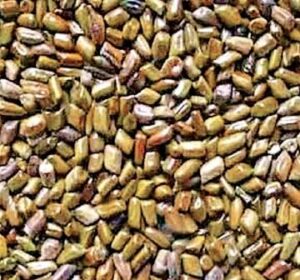
Common names: Kuvadia seeds, Stinking cassia, Chinese senna, Java bean, peanut weed.
Local names: Panwar, Chakunda, chakvat, Takla
Nutritive value: It is good source of energy and protein (TDN 55% and CP 16%) for cattle.
Deleterious factors: The seeds contain 0.083% crysophanic acid which is considered to be anti-nutritional factor. Kuvadia seeds have some odour that animals do not like which makes them unpalatable. Most of the toxic factor is removed during cold water treatment by soaking seeds
in cold or hot water.
Inclusion: As such seeds are not palatable but when boiled and mixed
with other concentrates, animals very well consume it. The seeds after grinding can be incorporated at 15% level in the concentrate mixture of bullocks and lactating cows.
· Potato waste
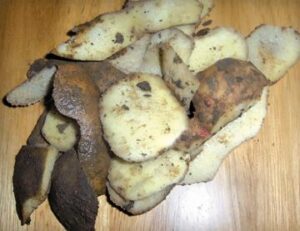
Nutritive value: Potato waste is an excellent energy source for feedlot cattle. Potato waste meal produced by drying and grinding whole potatoes, potato pulp and peelings and discarded potato chips contain 7.6% CP, 7.0% EE, 4% ash.
Inclusion: Large amount of discarded potato can be fed to beef cattle after cattle have been adopted to such rations. The biggest
problem that has managed with potato waste is water, as raw
potatoes contain about 80% water. Animal feed pellets can be prepared from unmarketable potato, barley and maize.
· Sugarcane bagasse
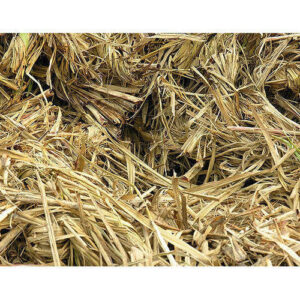
Sugarcane bagasse is the fibrous portion which leaves the last processing stage of sugar mill. It is the residue of sugar cane stalks after the juice has been pressed out in the factories.
Nutritive value: It contains 3.5% CP and 35% TDN.
Deleterious factors: The low digestibility, high lignin (>20%) and very low nitrogen content of raw bagasse limit its inclusion in feeds. Nutritive value of bagasse can be improved by various ways like pre-digestion by chemical and physical methods. Cemical treatments include alkali (sodium hydroxide) and ammonia (gas) or urea treatment.
Inclusion: Bagasse and bagasse pith are often used as fillers in
compound diet and as carriers for molasses or urea-molasses
mixture.
· Sugarcane tops
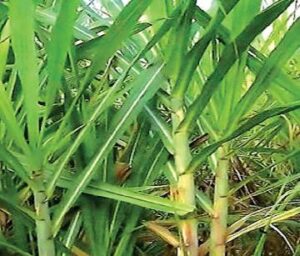
Common name: Sugarcane
Local names: Eekh, Ganna, Wade, Cheruku
Nutritive value: The feeding value of fresh cane tops is not very promising. It contains 3% CP and 45% TDN. It contains oxalate as a deleterious factor.
Inclusion: The material serves as roughages in comjugation with
concentrates. Sugarcane tops can be very well ensiled alone as well
as with 0.5% urea. The silage is well acceptable to crossbred cattle
and contains 47.8% TDN.
· Tea waste
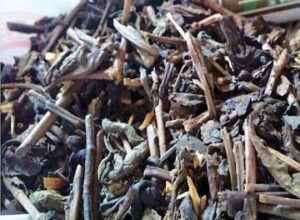
Nutritive value: The decaffeinated tea waste is a moderate source of energy and protein i.e. 58% TDN and 17.94% CP. Tea waste contains about 1.9% tannic acid.
Inclusion: The level of inclusion should not exceed to 10-15% because of its low TDN value. It is not very palatable and should therefore be mixed with more palatable ingredients for efficient use.
· Tomato waste
Common name: Tomato
Local names: Tamatar, Takkali
Nutritive value: The TDN and DCP content is 55% and 15% , respectively.
Inclusion: It can be used upto 50% and 16% level, respectively in the ration of adult bullocks and milch cows without any adverse effect.
· Warai bran
Nutritive value: Warai bran contains about 57.4% TDN and 6.24% CP. So it is average source of protein and energy.
Inclusion: Warai bran can br incorporated up to 30% level in the concentrate mixture of crossbred calves and lactating cows. The bran can replace wheat bran/rice bran by suitably adjusting the protein contents in the ration.
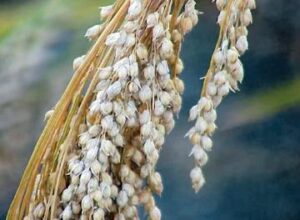
WARAI
Conclusion :
NCFR are end products of production and consumption that have not been used. They are mainly organic and can be in a solid, slurry or liquid form. Their economic value is often very less. Fruit wastes such as banana rejects and pineapple pulp by comparison have sugars which are energetically very beneficial. The feed crops which generate valuable NCFR are excellent sources of fermentable carbohydrates eg. Cassava and Sweet potato and this is an advantage to ruminants because of their ability to utilize inorganic nitrogen. Concerning the feeds of crop origin, the majority are bulky poor-quality cellulosic roughages with a high crude fibre and low nitrogen contents, suitable for feeding to ruminants. They have considerable potential as feed materials and their value can be increased if they are converted into some usable products.
While feeding attention needs to be paid towards the inclusion level of the resources as they vary with the crop one intends to use. The farmer should also know about the deleterious factors of the fodder and treatment regarding the same. The NCFR differs from region to region. All fodders cannot be found in all regions of India throughout the year.
Dr. Pranjali Thakre, Dr. B.Muralidhar Reddy, Dr. Sunil Nayak, Dr. Ankur Khare, Dr. Rahul Sharma, Dr. Amit Chaurasiya.
Department of Animal Nutrition, College of Veterinary Science and Animal Husbandry, Jabalpur (Madhya Pradesh)


